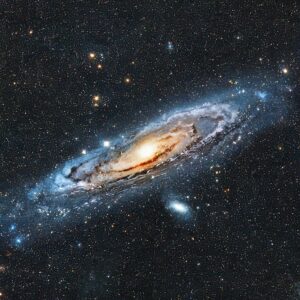Table of Contents
In the vast and ever-expanding universe, galaxies drift and dance according to the gravitational rhythms laid down by the cosmos. Among these celestial entities, the Milky Way, our home galaxy, and Andromeda, its nearest spiral neighbor, are set on a collision course that promises a cosmic spectacle of unparalleled proportions. This impending galactic merger, though billions of years away, offers a fascinating glimpse into the dynamic nature of the universe and the future of our own galaxy. Let’s embark on an astronomical journey to understand what happens when galaxies collide and what this means for the Milky Way and its inhabitants.
The Cosmic Dance of Galaxies
Galaxies are not static. They move and evolve, influenced by the gravitational pull of everything around them. The Milky Way and Andromeda are no exceptions. Currently, Andromeda is hurtling towards the Milky Way at about 110 kilometers per second (68 miles per second). This might seem fast, but given the vast distances involved, their meeting is still roughly 4 billion years in the future.
A Galactic Merger Like No Other
When two galaxies collide, it’s less of a catastrophic crash and more of a gravitational tango. Galaxies are mostly empty space, so the stars within them rarely collide directly. Instead, their mutual gravity will warp and distort their shapes, flinging stars into new orbits and triggering waves of star formation from compressed gas clouds.
What Will Happen to the Solar System?
The fate of our solar system in this grand event is uncertain but not necessarily dire. There’s a chance we could be flung into a new region of the resulting galaxy or even ejected into intergalactic space. However, even in these scenarios, it’s unlikely that the solar system itself would be disrupted. The distances between stars are so vast that direct collisions are improbable.
A New Celestial Landscape
One of the most striking outcomes of this merger will be the transformation of our night sky. Imagine looking up to see a sky ablaze with new stars, nebulae, and perhaps even a bright center where Andromeda once stood alone in the distance. Over time, the merged galaxies will settle into a new shape, likely an elliptical galaxy rather than the spirals they once were.
The Birth of Milkomeda
Astronomers often refer to the future merged galaxy as “Milkomeda” or “Milkdromeda.” This single entity will mark the beginning of a new chapter in galactic evolution. The merger is not merely an end but also a beginning – a catalyst for star formation and the creation of new worlds.
The Role of Dark Matter
Dark matter plays a crucial role in galactic collisions. Although invisible and undetectable directly, its massive gravitational influence helps shape the outcome of galaxy mergers. Understanding how dark matter interacts during these events can provide insights into its mysterious nature.
Navigating Through Time: The Far Future
The Milky Way-Andromeda collision is just one event in a long cosmic timeline. Following this merger, the universe will continue to expand, galaxies will continue to evolve, and stars will be born and die. Over trillions of years, the universe will age and change in ways that are difficult to imagine but fascinating to contemplate.
A Perspective from Earth
For inhabitants of Earth or any descendants we might have elsewhere in the galaxy by then, this event offers both challenges and opportunities. While direct impact on our planet is unlikely due to the vast distances between stars, any shift in our position could affect how we view the universe and our place within it.
Conclusion: Embracing Cosmic Change
The eventual collision between the Milky Way and Andromeda galaxies serves as a reminder of the dynamic nature of our universe. It challenges us to consider not only our place in the cosmos but also how we understand time, change, and continuity on cosmic scales. As we peer into the night sky, we witness not only the beauty of the stars but also the unfolding story of which we are a part.
This grand cosmic event reminds us that change is an inherent aspect of existence, from the smallest particles to the vast reaches of intergalactic space. As we continue to explore and understand these monumental processes, we gain not only scientific knowledge but also a deeper appreciation for the marvels of our universe.
